Nikolaas Tinbergen, Professor of Animal Behaviour at the University of Oxford.
Excerpt from the lecture delivered to the Nobel Foundation in Stockholm on 12 December 1973 when he received the Nobel Prize for Physiology or Medicine (shared with K. Lorenz and K. von Frisch)
[See video of the lecture at nobelprize.org (the exemple about Alexander beguins at 32:40)]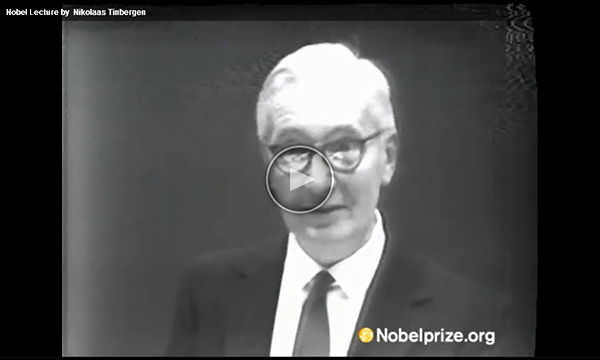
Many of us have been surprised at the unconventional decision of the Nobel Foundation to award this year’s prize for Physiology or Medicine to three men who had until recent years been regarded as "mere animal watchers". Since at least Konrad Lorenz and I could not really be described as physiologists, we must now conclude that our scientia amabilis is now being acknowledged as an integral part of the eminently practical field of medicine. It is for this reason that I have decided to discuss today two concrete examples of how the old method of "watching and wondering" about behaviour (which incidentally we reviewed rather than invented) can indeed contribute to the relief of human suffering, in particular suffering caused by stress. It seems to me fitting to do this in a city already renowned for important work on psychosocial stress and psychosomatic diseases.
My second example of the usefulness of an ethological approach to medicine has quite a different history. It concerns the work of a very remarkable man, the late F.M. Alexander. His research started some 50 years before the revival of ethology, for which we are now being honoured, yet his procedure was very similar to modern observational methods, and we believe that his achievements and those of his pupils deserve close attention.
Alexander, who was born in 1869 in Tasmania, became at an early age a "reciter of dramatic and humorous pieces". Very soon he developed serious vocal trouble and he came very near to losing his voice altogether. When no doctor could help him, he took matters into his own hands. He began to observe himself in front of a mirror, and then he noticed that his voice was at its worst when he adopted the stances which to him felt appropriate and right for what he was reciting. Without any outside help he worked out, during a series of agonizing years, how to improve what is now called the "use" of his body musculature in all his postures and movements. And, the remarkable outcome was that he regained control of his voice. This story of persistence, shown by a man without medical training, is one of the true epics of medical research and practice.
Once Alexander had become aware of the misuse of his own body, he began to observe his fellowmen, and he found that, at least in modern Western society, the majority of people stand, sit and move in an equally defective manner.
Encouraged by a doctor in Sydney, he now became a kind of missionary. He set out to teach -first actors, then a variety of people- how to restore the proper use of their musculature. Gradually he discovered that he could in this way alleviate an astonishing variety of somatic and mental illnesses. He also wrote extensively on the subject. And finally he taught a number of his pupils to become teachers in their turn, and to achieve the same results with their patients. Whereas it had taken him years to work out the technique and to apply it to his own body, a successful course became a matter of months, with occasional refresher sessions afterward. Admittedly, the training of a good Alexander teacher takes a few years.
For scores of years a small but dedicated number of pupils has continued his work. Their combined successes have recently been described by Barlow. I must admit that his physiological explanations of how the treatment could be supposed to work (and also a touch of hero worship in his book) made me initially a little doubtful and even a little sceptical. But the claims made, first by Alexander, and reiterated and extended by Barlow, sounded so extraordinary that I felt I ought to give the method at least the benefit of the doubt. And so, arguing that medical practice often goes by the sound empirical principle of "the proof of the pudding is in the eating" my wife, one of our daughters, and I decided to undergo treatment ourselves, and also to use the opportunity for observing its effects as critically as we could. For obvious reasons, each of us went to a different Alexander teacher.
We discovered that the therapy is based on exceptionally sophisticated observation, not only by means of vision but also to a surprising extent by using the sense of touch. It consists in essence of no more than a very gentle, first exploratory, and then corrective manipulation of the entire muscular system. This starts with the head and neck, then very soon the shoulders and the chest are involved and finally the pelvis, legs and feet, until the whole body is under scrutiny and treatment. As in our own observations of children, the therapist is continuously monitoring the body and adjusting his procedure all the time. What is actually done varies from one patient to another, depending on what kind of misuse the diagnostic exploration reveals. And naturally, it affects different people in different ways. But between the three of us, we already notice, with growing amazement, very striking improvements in such diverse things as high blood pressure, breathing, depth of sleep, overall cheerfulness and mental alertness, resilience against outside pressures and also in such a refined skill as playing a stringed instrument.
So from personal experience we can already confirm some of the seemingly fantastic claims made by Alexander and his followers, namely that many types of underperformance and even ailments both mental and physical can be alleviated, sometimes to a surprising extent by teaching the body musculature to function differently. And although we have by no means finished our course, the evidence given and documented by Alexander and Barlow of beneficial effects on a variety of functions no longer sounds so astonishing to us. Their long list includes first of all what Barlow calls the "rag bag" of rheumatism, including various forms of arthritis, then respiratory troubles, and even potentially lethal asthma; following in their wake, circulation defects, which may lead to high blood pressure and also to some dangerous heart conditions: gastrointestinal disorders of many types; various gynaecological conditions: sexual failures; migraines and depressive states that often lead to suicide; in short, a very wide spectrum of diseases, both somatic and mental that are not caused by identifiable parasites.
Although no one would claim that the Alexander treatment is a cure-all in every case, there can be no doubt that it often does have profound and beneficial effects; and I repeat once more, both in the mental and somatic sphere.
The importance of the treatment has been stressed by many prominent people, for instance John Dewey, Aldous Huxley, and perhaps more convincing to us by scientists of renown, such as Coghill, Dart and the great neurophysiologist Sherrington. Yet, with few exemptions, the medical profession has largely ignored Alexander, perhaps under the impression that he was the centre of some kind of cult, and also because the effects seemed difficult to explain. And this brings me to my next point.
Once one knows that an empirically developed therapy has demonstrable effects, one likes to know how it could work, what its physiological explanation could be. And here some recent discoveries in the borderline field between neurophysiology and ethology can make some aspects of the Alexander therapy more understandable and more plausible than they could have been in Sherrington's time.
One of these new discoveries concerns the key concept of reafference. There are many strong indications that, at various levels of integration, from single muscle units up to complex behaviour, the correct performance of many movements is continuously checked by the brain. It does this by comparing a feedback report that says "orders carried out" with the feedback expectation for which, with the initiation of each movement, the brain has been alerted. Only when the expected feedback and the actual feedback match does the brain stop sending out commands for corrective action. Already the discoverers of this principle, von Hoist and Mittelstaedt, knew that the functioning of this complex could vary from moment to moment with the internal state of the subject -the "target value" or Sollwert of the expected feedback changes with the motor commands that are given-. But what Alexander discovered beyond this is that a lifelong misuse of the body muscles (such as caused by, for instance too much sitting and too little walking) can make the entire system go wrong. As a consequence reports that "all is correct" are received by the brain (or perhaps interpreted as correct) when in fact all is very wrong. A person can feel at ease, for example, when slouching in front of a television set, when in fact he is grossly abusing his body. I can show you only a few examples, but they will be familiar to all of you.
(Figures from W. Barlow, The Alexander Principle (Gollancz, London 1973))
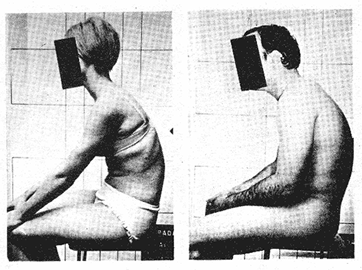
Typical slumped sitting position.
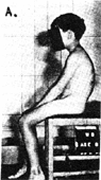
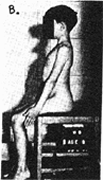
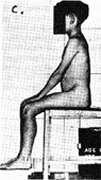
Three sitting positions: (a) slumping; (b) sitting too straight; and (c) balanced.
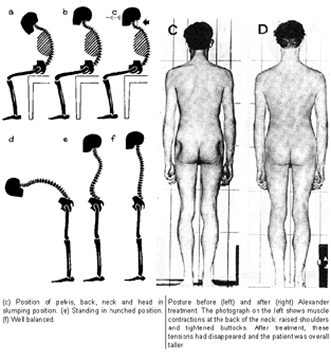
It is still an open question exactly where in this complex mechanism the matching procedure goes wrong under the influence of consistent misuse. But the modern ethologist feels inclined with Alexander and Barlow, to blame phenotypic rather than genetic causes for misuse. It is highly unlikely that in their very long evolutionary history of walking upright the hominids have not had time to evolve the correct mechanisms for bipedal locomotion. This conclusion receives support from the surprising, but indubitable fact that even after 40 to 50 years of obvious misuse one's body can (one might say) snap back into proper, and in many respects more healthy, use as a result of a short series of half-hourly sessions.
Proper stance and movement are obviously genetically old, environment-resistant behaviours. Misuse, with all its psychosomatic or rather somatopsychic consequences must therefore be considered a result of modern living conditions of a culturally determined stress. I might add here that I am not merely thinking of too much sitting, but just as much of the cowed posture that one assumes when one feels that one is not quite up to one's work, when one feels insecure.
Second, it need not cause surprise that a mere gentle handling of body muscles can have such profound effects on both body and mind. The more that is being discovered about psychosomatic diseases, and in general about the extremely complex two-way traffic between the brain and the rest of the body, the more obvious it has become that too rigid a distinction between mind and body is of only limited use to medical science, in fact can be a hindrance to its advance.
A third biological interesting aspect of the Alexander therapy is that every session clearly demonstrates that the innumerable muscles of the body are continuously operating as an intricately linked web. Whenever a gentle pressure is used to make a slight change in posture, the neck muscles react immediately. Conversely, when the therapist helps one to release the neck muscles, it is amazing to see quite pronounced movements, for instance of the toes, even when lying on a couch.
In this short sketch I can do no more than characterise and recommend the Alexander treatment as an extremely sophisticated form of rehabilitation, or rather of redeployment of the entire muscular equipment, and through that of many other organs. Compared with this, many types of physiotherapy which are now in general use look surprisingly crude and restricted in their effect and sometimes even harmful to the rest of the body.
What then is the upshot of these few brief remarks about early childhood autism and about the Alexander treatment? What have these two examples in common? First of all, they stress the importance for medical science of open-minded observation, of "watching and wondering". This basic scientific method is still too often looked down on by those blinded by the glamour of apparatus, by the prestige of tests, and by the temptation to turn to drugs. But it is by using this old method of observation that both autism and general misuse of the body can be seen in a new light; to a much larger extent than is now realised both could very well be due to modern stressful conditions.
But beyond this, I feel that my two excursions into the field of medical research have much wider implications. Medical science and practice meet with a growing sense of unease and of lack of confidence from the side of the general public. The causes of this are complex, but at least in one respect the situation could be improved: a little more open-mindedness, a little more collaboration with other biological sciences, and a little more attention to the body as a whole and to the unity of body and mind could substantially enrich the field of medical research. I therefore appeal to our medical colleagues to recognise that the study of animals -in particular "plain" observation- can make useful contributions to human biology not only in the field of somatic malfunctioning, but also in that of behavioural disturbances, and ultimately help us to understand what psychosocial stress is doing to us. It is stress in the widest sense, the inadequacy of our adjustability that will become perhaps the most importance disruptive influence in our society.
If I have today emphasised the applicability of animal behaviour research, I do not want to be misunderstood. As in all sciences, applications come in the wake of research motivated by sheer intellectual curiosity. What this occasion enables me to emphasise is that biologically oriented research into animal behaviour, which has been done so far with very modest budgets, deserves encouragement, whatever the motivation and whatever the ultimate aims of the researcher. And we ethologists must be prepared to respond to the challenge if and when it comes.